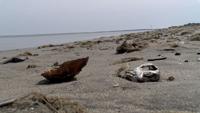SUSSEX COUNTY, Del.- People heading to Sussex County beaches have to walk around dead fish and crabs that have washed up.
Beachgoers including Bonnie Roberts-Burke who live part time in Broadkill Beach want to know why it is happening.
"This weekend I saw many many more but there are so many carcasses, mostly half or three-quarter eaten and I always worry about it but I don't know what the cause is but I would really like to," Roberts-Burke said.
The Delaware Department of Natural Resources & Environmental Control (DNREC) says there has been an influx over the past month of Atlantic menhaden in the Atlantic Ocean and the Delaware Bay with large schools from Cape Henlopen to Port Mahon in Kent County.
DNREC posted about the issue on March 9 on its Delaware Fish and Wildlife Facebook page.
"Atlantic menhaden are a major food source for larger fish, birds and marine mammals. The large schools of Atlantic menhaden in the ocean and bay have attracted high numbers of these predators that often injure the fish that wash ashore or panic the fish that then beach themselves."
About a half mile from the Broadkill Road beach access, there's many more dead fish and dead crabs laying around and this is a concern for people who live here and for people that visit here and walk the beach.
But Delaware Center For The Inland Bays Executive Director Chris Bason says this could be due to a virus called Vibrio.
"It's infecting the fish and it's causing them to behave erratically and die," Bason said. "And some people are referring to the disease it causes as spinning disease because you see some of the fish slowly spinning at the surface before they pass away."
Going three miles north to Prime Hook Beach, the scene is the same. One that has been seen in years past and beachgoers may continue to see in the days ahead.
DNREC says if anyone notices something that could be a suspected fish kill on a beach or shore to call the Fisheries Section of the department.







